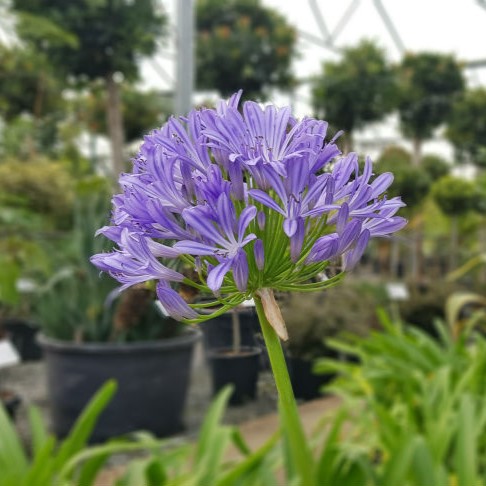Mastering the Art of Agapanthus Treatment: Crucial Steps for Healthy Development and Vivid Blooms
In the realm of gardening, the farming of agapanthus stands as a fulfilling undertaking for those who look for to nurture these classy blooming plants. With their striking blooms and stylish foliage, agapanthus has actually caught the attention of garden enthusiasts worldwide. Nonetheless, accomplishing optimal development and vivid blossoms calls for a nuanced technique that includes various necessary steps. From picking the appropriate selection to understanding trimming strategies, the journey towards growing flourishing agapanthus plants is multifaceted and holds the crucial to unlocking the complete possibility of these agricultural gems.

Selecting the Right Agapanthus Variety

When selecting the right Agapanthus selection for your garden, think about elements such as environment suitability, blossom shade, and development practice. Agapanthus, generally called Lily of the Nile or African lily, is available in a variety of colors varying from tones of purple and blue to white. Select a bloom color that complements your existing garden palette to develop an unified landscape. In addition, think about the climate in your area to ensure the Agapanthus variety you pick can thrive in your particular conditions. Some selections are a lot more tolerant of chilly temperature levels, while others choose warmer environments. Comprehending the development habit of different Agapanthus varieties is crucial for appropriate placement within your yard. Some selections have a clumping growth habit, suitable for boundaries or containers, while others have an even more spreading nature, appropriate for ground cover or mass plantings. By very carefully assessing these elements, you can select the excellent Agapanthus variety to improve the beauty of your garden.
Ideal Planting Conditions
Taking into consideration the optimal environmental demands is essential for effective Agapanthus cultivation. Agapanthus plants are delicate to cool temperatures and ought to be safeguarded from frost during winter months.
To make sure healthy and balanced growth and vibrant blooms, plant Agapanthus light bulbs at a deepness of about 2-4 inches and room them 8-12 inches apart. Mulching around the base of the plants assists maintain moisture and subdues weed development.
Watering and Feeding Tips
Maintaining proper dampness levels and offering essential nutrients are crucial elements in the care regimen for Agapanthus plants. It is vital to strike an equilibrium when it comes to watering Agapanthus. If overwatered, these plants choose consistently damp soil yet are prone to root rot. During the growing period, water deeply when a week, making sure the soil is well-draining to avoid waterlogging. In hotter climates or during periods of dry spell, more frequent watering may be essential to maintain the soil uniformly wet. Nevertheless, minimize watering in the wintertime to stop waterlogged conditions.
Feeding Agapanthus is important for advertising healthy growth and respected blossoms. Use a well balanced fertilizer, such as a 10-10-10 formula, in the very early springtime as new growth arises. Repeat this application every 6-8 weeks throughout the growing season. Prevent too much fertilizing, as it can lead to lavish vegetation at find out here now the expense of blooms. Always follow the supplier's guidelines for correct dilution and application methods. By adhering to these watering and fertilizing pointers, you can guarantee your Agapanthus plants thrive and produce lively, resilient blooms.
Trimming Methods for Agapanthus
Trimming Agapanthus plants at the ideal times and with proper techniques is important for maintaining their health and wellness and promoting optimum development and blooming. The excellent time to trim Agapanthus is in late winter season or early springtime before brand-new growth emerges.
Deadheading spent blossoms can likewise redirect the plant's power right into generating more blooms instead than setting seeds. If you desire to collect seeds for proliferation, leave some flowers to dry and fully grown on the plant.
Keep in mind to utilize clean, sharp devices to make exact cuts and lower the risk of presenting diseases. Agapanthus. Regular pruning will certainly aid maintain your Agapanthus looking neat and healthy and balanced while ensuring an abundant display screen of attractive flowers
Dealing With Usual Bugs and Illness
After making certain correct pruning methods for Agapanthus, it is essential to deal with common bugs and conditions that can impact the health and vitality of these plants. Agapanthus plants are usually durable but can still come down with certain concerns. One typical insect that affects Agapanthus is the Agapanthus gall midget. This small, orange fly lays its eggs in the vegetation, resulting in altered growth and flower buds that fail to open up. To battle this pest, trim and destroy any afflicted plant my site parts and consider making use of insecticidal soap.
In addition, Agapanthus plants can experience from root rot if they are grown in inadequately draining soil. By being attentive and taking timely action against illness and parasites, you can help your Agapanthus plants prosper and create vivid blooms. Agapanthus.

Conclusion
Finally, understanding the art of agapanthus treatment entails picking the right range, giving excellent planting conditions, correct watering and feeding, suitable trimming techniques, and attending to usual insects and conditions. By adhering to these essential steps, you can make sure healthy and balanced development and vivid blossoms for your agapanthus plants. Bear in mind to Agapanthus consistently check and maintain your plants to advertise their general wellness and longevity.
To guarantee healthy development and dynamic blossoms, plant Agapanthus bulbs at a depth of concerning 2-4 inches and space them 8-12 inches apart. By following these watering and fertilizing pointers, you can guarantee your Agapanthus plants thrive and create vivid, lasting blooms.
One usual bug that influences Agapanthus is the Agapanthus gall midget. Additionally, Agapanthus plants can endure from origin rot if they are planted in inadequately draining pipes soil. By following these essential actions, you can guarantee healthy development and lively blooms for your agapanthus plants.
 Shaun Weiss Then & Now!
Shaun Weiss Then & Now! Andrew Keegan Then & Now!
Andrew Keegan Then & Now! Traci Lords Then & Now!
Traci Lords Then & Now! Atticus Shaffer Then & Now!
Atticus Shaffer Then & Now! Robin McGraw Then & Now!
Robin McGraw Then & Now!